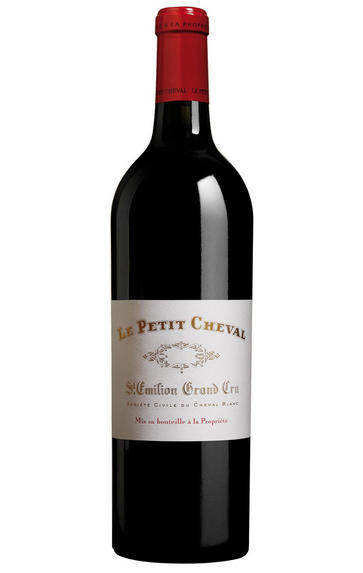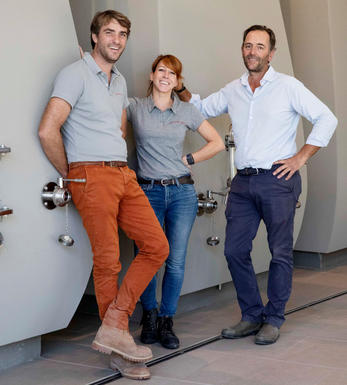
2019 Le Petit Cheval, St Emilion, Bordeaux

Critics reviews
Tasted blind.
The 2019 Petit Cheval has a very attractive cedar and tobacco-infused bouquet that seems precise and supremely well-focused. The oak is neatly assimilated. The palate is medium-bodied with a bolder presence than intimated by the aromatics, sweet and layered black fruit, quite plush, satin texture with a persistent and seductive, modern style finish. Lovely.
Drink 2025 - 2045
Neal Martin, Vinous.com (February 2023)
The 2019 Petit Cheval is a stunning second wine - if it can even be called that. In 2019, Petit Cheval is a blend of four parcels that were in the Grand Vin in 2018. Dark, supple and expressive, the 2019 offers up an exotic mélange of black cherry, spice, new leather and graphite, all of which build effortlessly in the glass. The Petit represents 5.5% of the château's production in 2019, but it is more of a second selection, as 12% of the wine that year was sold in bulk.
Drink 2027 - 2039
Antonio Galloniy, Vinous.com (February 2022)
Exhibiting aromas of plums, sweet wild berries, rose petals, spices and cigar wrapper, the 2019 Le Petit Cheval is medium to full-bodied, velvety and seamless, with supple tannins and succulent acids. Pierre-Olivier Clouet explains that he aspires to produce 100% Cheval Blanc and that, as a result, this cuvée simply represents anything that doesn't belong in the Grand Vin's blend. Of course, however, it shares some of the latter's DNA.
One of Bordeaux's most complex terroirs, Cheval Blanc sits on the site of an ancient river delta, with (to generalize) clay-rich soils in the lower-lying parts where rivulets once flowed and gravel and sand elsewhere. This complexity is reflected, of course, in the resulting wine, but also in how it is farmed and made, with thoughtful use of cover crops according to soil type and parcel-by-parcel vinification.
A concerted effort is being made, moreover, to bring life back to the vineyard, with hedges of native species to act as wildlife corridors, and fruit trees planted among the vines. The same attention to detail that's applied in the vineyards, for example with regard to developing and testing an in-house massal selection, is applied in the cellar, where cooperage trials are notable for their exigence. All of that shows in the glass.
On my most recent visit, technical director Pierre-Olivier Clouet and I tasted the 2019 in the context of the last 10 vintages of Cheval Blanc, and it stood out even in such illustrious company, with—to my palate—2016 its only plausible rival for the title of Cheval Blanc of the decade. Readers with the requisite disposable income won't want to miss it.
Drink 2021 - 2035
William Kelley, Wine Advocate (April 2022)
Second wine of Cheval Blanc. 56% Merlot and 44% Cabernet Franc.
This is so floral and beautiful with roses, violets and some lavender. Spices and stems, too. Medium-bodied, firm and bright with compact density to the wine. Beautiful tannins. This is extremely structured.
Try after 2027
James Suckling, JamesSuckling.com (March 2022)
At only 5.5% production, this is the rarest of the Cheval wines. A blend of 56% Merlot and 44% Cabernet Franc.
Gorgeous perfume on the nose, delicate but expressive blackcurrants and black cherries, has a real dark side to it but lifted by the perfume. Great acidity from the start, bright and vibrant with a cool and fresh mid palate. This feels quite charming and confident without being too confident. Round and smooth with mouthwatering acidity and lovely bright fruits but at the same time the texture is so soft and comforting.
It feels like a cooler baby brother to the grand vin, one who has an effortless style. Brilliant. There are no specific plots of Petit Cheval so all the plots in this 2019 were in the grand vin in 2018, so there is 'zero consistency in terms of quantity, commercialisation and proportion' for Petit Cheval says technical director Pierre Olivier Clouet.
Drink 2025 - 2045
Georgina Hindle, Decanter.com (January 2022)
The 2019 Château Cheval Blanc Le Petit Cheval is a solid (better than solid, actually) second wine offering beautiful elegance, purity, and finesse, which is what this estate does better than anyone. Complex notes of red and black currants, forest floor, cedarwood, and tobacco all define the bouquet, and it's medium-bodied, with silky, fine-grained tannins, no hard edges, and just a seamless, elegant, layered style that will drink spectacularly well for 10-15 years.
Drink 2022 - 2037
Jeb Dunnuck, JebDunnuck.com (April 2022)
About this WINE

Château Cheval Blanc
Château Cheval Blanc, a 1er Grand Cru Classé (A) is unquestionably the leading estate in St. Emilion. It is located in the north-west of the St. Emilion appellation, bordering Pomerol.
Cheval Blanc's vineyards (Merlot 39%, Cabernet Franc 57%, Malbec 3%, Cabernet Sauvignon 1%) enjoy a variety of soils: gravel, clay and sand, all underpinned by an impermeable sedimentary rock (`crasse de fer'). Fermentation and maceration last 4 weeks in stainless steel vats, followed by 18 months' maturation in new oak barrels.
Cheval Blanc produces the most famous Cabernet Franc-based wine in the world and present régisseur Pierre Lurton is amongst the most talented winemakers working in Bordeaux today. Cheval Blanc requires a minimum 10 years of bottle age and the best vintages can last for 50 years or more.

St Émilion
St Émilion is one of Bordeaux's largest producing appellations, producing more wine than Listrac, Moulis, St Estèphe, Pauillac, St Julien and Margaux put together. St Emilion has been producing wine for longer than the Médoc but its lack of accessibility to Bordeaux's port and market-restricted exports to mainland Europe meant the region initially did not enjoy the commercial success that funded the great châteaux of the Left Bank.
St Émilion itself is the prettiest of Bordeaux's wine towns, perched on top of the steep limestone slopes upon which many of the region's finest vineyards are situated. However, more than half of the appellation's vineyards lie on the plain between the town and the Dordogne River on sandy, alluvial soils with a sprinkling of gravel.
Further diversity is added by a small, complex gravel bed to the north-east of the region on the border with Pomerol. Atypically for St Émilion, this allows Cabernet Franc and, to a lesser extent, Cabernet Sauvignon to prosper and defines the personality of the great wines such as Ch. Cheval Blanc.
In the early 1990s there was an explosion of experimentation and evolution, leading to the rise of the garagistes, producers of deeply-concentrated wines made in very small quantities and offered at high prices. The appellation is also surrounded by four satellite appellations, Montagne, Lussac, Puisseguin and St. Georges, which enjoy a family similarity but not the complexity of the best wines.
St Émilion was first officially classified in 1954, and is the most meritocratic classification system in Bordeaux, as it is regularly amended. The most recent revision of the classification was in 2012

Merlot/Cabernet Franc
Merlot and Cabernet Franc are grape varieties commonly used in Bordeaux-style blends, particularly in the Bordeaux region of France. When these two grapes are blended, they can create a wine that combines the best characteristics of each variety.
Merlot is known for its smoothness, soft tannins, and ripe fruit flavours. It often contributes black cherry, plum, and chocolate flavours to the blend. The grapes are relatively easy to grow and ripen earlier than other Bordeaux varieties, making them versatile for blending.
Cabernet Franc, on the other hand, adds structure, depth, and complexity to the blend. It typically brings aromas of red fruits such as raspberry and strawberry, along with herbal notes like bell pepper and tobacco. These grapes have thinner skins and can be more challenging to cultivate, requiring specific growing conditions to reach their full potential.
When Merlot and Cabernet Franc are combined, the result is a well-balanced wine with various flavours and aromas. The blend often exhibits a Bordeaux wine's medium to full body, along with a smooth texture and moderate tannins. The specific flavour profile can vary depending on the proportions of each grape in the blend and the terroir and winemaking techniques employed.


Buying options
Add to wishlist
Description
At only 5.5% production, this is the rarest of the Cheval wines. A blend of 56% Merlot and 44% Cabernet Franc.
Gorgeous perfume on the nose, delicate but expressive blackcurrants and black cherries, has a real dark side to it but lifted by the perfume. Great acidity from the start, bright and vibrant with a cool and fresh mid palate. This feels quite charming and confident without being too confident. Round and smooth with mouthwatering acidity and lovely bright fruits but at the same time the texture is so soft and comforting.
It feels like a cooler baby brother to the grand vin, one who has an effortless style. Brilliant. There are no specific plots of Petit Cheval so all the plots in this 2019 were in the grand vin in 2018, so there is 'zero consistency in terms of quantity, commercialisation and proportion' for Petit Cheval says technical director Pierre Olivier Clouet.
Drink 2025 - 2045
Georgina Hindle, Decanter.com (January 2022)
wine at a glance
Delivery and quality guarantee